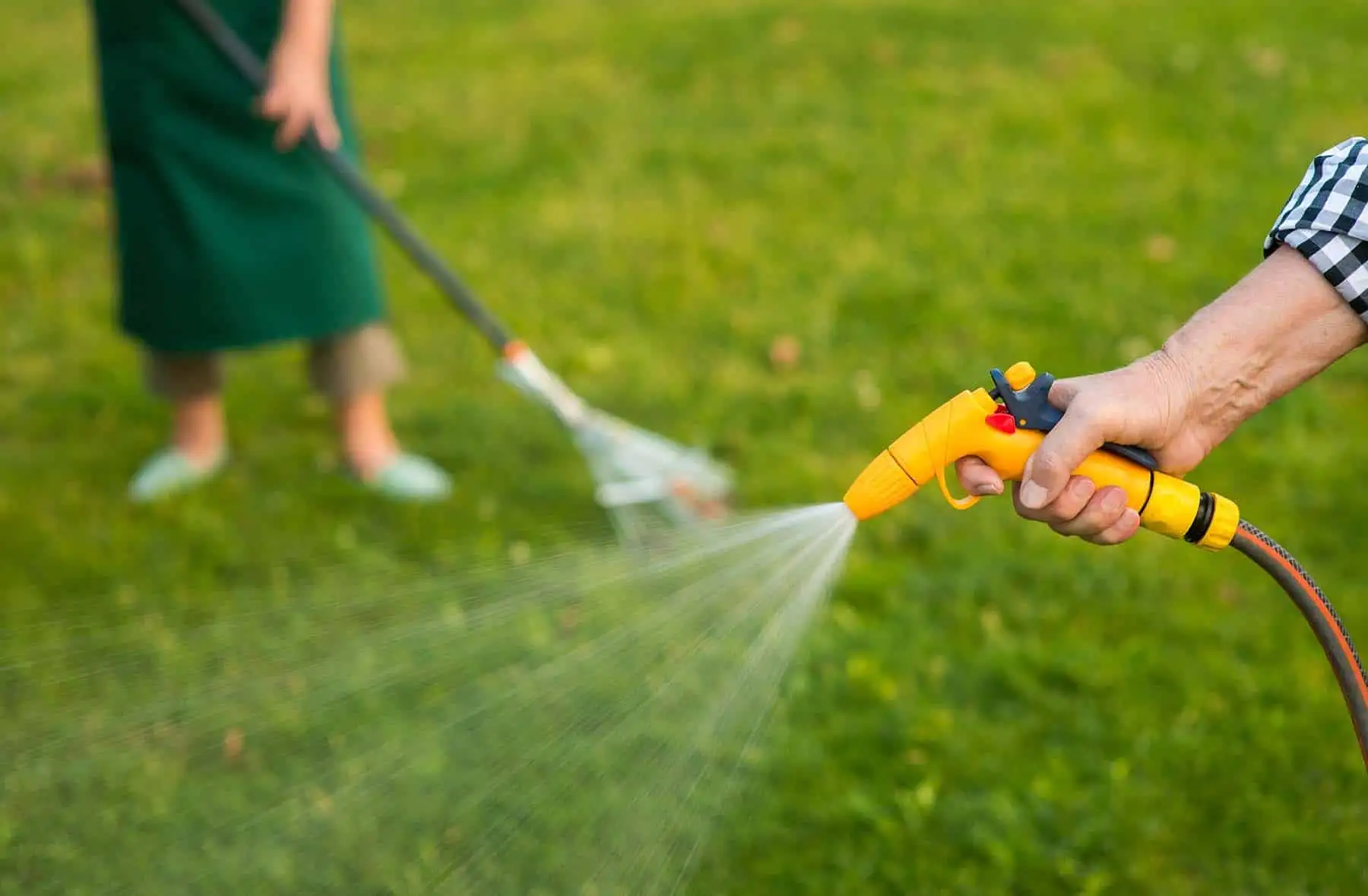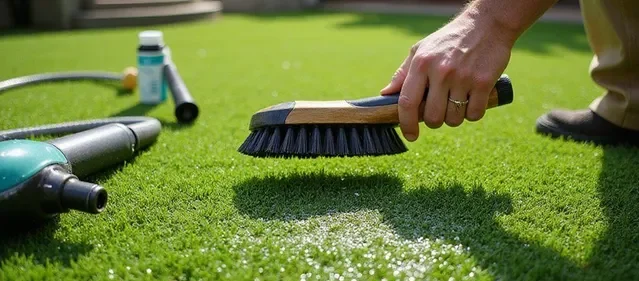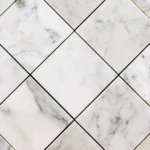Artificial grass is a smart way to keep your lawn green all year without the work of mowing, watering, or seeding. But to keep it fresh and safe, regular cleaning is essential. Studies have shown that bacteria like Staphylococcus aureus can survive up to 40 days on synthetic turf if it’s not disinfected properly. Knowing how to disinfect synthetic grass can make all the difference between a clean, odor-free lawn and one that spreads germs or smells unpleasant.
Why Cleaning and Disinfection Matter
You can’t always see what’s living on your lawn.
Outdoor turf may look spotless, yet it can host dust, pollen, pet waste, and bacteria. Research from environmental health journals found that synthetic surfaces can support more microbial activity than natural grass under certain conditions (NIH PMC). Regular maintenance keeps your turf safe and extends its lifespan by preventing buildup that can degrade synthetic fibers.
If you’re new to turf care, learn about long-term artificial grass maintenance and design tips on Low Maintenance Grass.
Step 1: Remove Surface Debris
Clean space equals better results.
Before disinfecting, clear leaves, dirt, and pet waste. Use a plastic rake or broom to avoid damaging blades. For balconies or small mats, sweep gently or shake them out—this is how to clean artificial grass on balcony or how to clean artificial grass mat safely. Removing debris prevents clogging and helps your disinfectant reach every fiber.
Step 2: Rinse Thoroughly with a Garden Hose
Water does the first deep clean.
Use a rinse garden hose to wash away dust, pollen, and small debris. In dusty or high-traffic areas, a quick rinse once or twice a week helps maintain freshness. Turf experts note that frequent rinsing can reduce microbial buildup by nearly 30 percent (Pro-Green).

This simple routine works for how to clean artificial grass from dust and prepares your surface for the next disinfecting step.
Step 3: Disinfect Using Safe, Natural Methods
Kill germs without killing your grass.
Skip harsh chemicals like bleach that may discolor or weaken fibers. Instead, try these safe disinfecting methods:
-
How to disinfect fake grass with vinegar – Mix equal parts white vinegar and water in a spray bottle. Mist the turf evenly and let it sit 10–15 minutes before rinsing. This natural acid neutralizes odor and bacteria without harming pets or kids.
-
Bio-enzymatic cleaning solution – Perfect for pet areas, these cleaners use enzymes to digest organic matter like dog urine, sweat, or food spills. They’re proven to cut odor-causing bacteria by over 90% when used weekly (EPA Safer Choice Program).
Both are ideal for how to clean fake grass from dog urine and how to sanitize your artificial grass effectively.
Step 4: Gently Scrub and Rinse Clean
Light pressure, strong results.
After applying your disinfectant, scrub lightly with a soft broom or brush to remove stains and dirt. Avoid metal bristles that can harm fibers. Then rinse clean using your hose again until water runs clear. Regular rinsing not only removes residues but also keeps blades from clumping together, giving the turf a natural bounce.
Step 5: Let It Dry and Fluff the Blades
Air does the finishing touch.
Allow the turf to air dry completely before use. Moist turf can trap odors or bacteria. Once dry, brush the grass to lift flattened areas. Turf that’s brushed and dried properly can last up to 25–30% longer than neglected lawns (Synthetic Turf Council).
If you want expert advice on turf styling and care, learn more about Artificial Grass for Home.
Step 6: Deep Clean Occasionally with a Pressure Washer
Power clean—without power damage.
For stubborn grime or odor, try cleaning artificial grass with pressure washer. Keep the pressure low and the nozzle at least 12 inches away to prevent lifting seams or damaging infill. Studies from turf maintenance experts show that monthly pressure cleaning can reduce odor complaints by up to 90 percent.
Best Tools for Cleaning Artificial Grass
Having the right tools makes turf cleaning simple and effective.
Tool Purpose Turf rake / stiff broom To fluff and lift turf fibers Garden hose To rinse dust and debris Leaf blower To clear dry leaves Soft scrub brush To remove stains or dirt Enzyme cleaner spray For pet-related odor control
How to Clean Artificial Grass with Dogs
Pets bring joy—but also germs.
Pet urine is one of the biggest challenges for turf owners. According to the AVMA, dog urine can contain over 40 types of bacteria, which can thrive on synthetic turf if not cleaned promptly. Here’s the right way:
-
Pick up solid waste immediately.
-
Rinse the area with water after each use.
-
Apply a bio-enzymatic cleaner or vinegar spray once a week.
-
Allow full drying before letting pets play again.
This approach keeps your turf odor-free and hygienic year-round. To handle other pet-related turf issues, read more about No More Mud, Weeds, and Pests.
Special Areas: Balcony and Indoor Carpets
Small spaces need smart care.
For how to clean artificial grass carpet in balcony or indoor mats, use mild soap with warm water and a sponge. Rinse well and dry under sunlight. UV light naturally helps reduce bacteria; researchers found that sunlight exposure cuts bacterial survival on turf by up to 99% within hours (Penn State University).
This routine also prevents mildew and fiber weakening, keeping indoor areas fresh.
Long-Term Turf Care Tips
A little routine goes a long way.
-
Avoid chlorine, bleach, or alcohol-based cleaners that degrade synthetic fibers.
-
Brush blades weekly to prevent flattening.
-
Rinse after storms or heavy use to remove dust and pollen.
-
Deep clean monthly using Artificial Grass Cleaner or natural vinegar solutions.
Following these habits keeps your turf’s color, feel, and hygiene intact for years. Learn more about design and care tips at Cozy Abode Living.
FAQs
1. How often should I disinfect artificial grass?
Ans:Once every month, or weekly for pet owners. Regular cleaning reduces bacteria by more than 70 percent, according to environmental studies.
2. Can vinegar harm turf?
Ans:No. When diluted 1:1 with water, it’s a safe disinfecting method that won’t discolor or degrade fibers.
3. What’s the best cleaner for pet odors?
Ans:Use a bio-enzymatic cleaning solution—it breaks down organic waste and removes odors naturally.
4. Is pressure washing safe for turf?
Ans:Yes, but only at low settings. Too much pressure can loosen infill or seams.
5. How do I remove stains and odors?
Ans:Apply vinegar or enzyme cleaner, scrub lightly, and rinse clean. Both are effective methods removing odors and removing stains safely.
Final Thoughts
Knowing how to disinfect artificial grass the right way keeps your outdoor and indoor spaces hygienic and vibrant. By combining rinsing, natural disinfectants, and occasional deep cleaning, you protect your family, pets, and investment.
With consistent care and the right tools, your artificial turf will stay fresh, soft, and safe for years—looking as good as the day it was installed.
For more inspiration and detailed guides, visit Cozy Abode Living and explore their wide collection of home and garden ideas.



